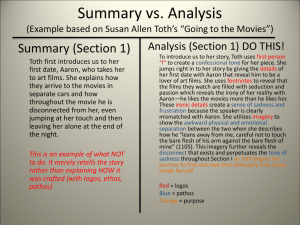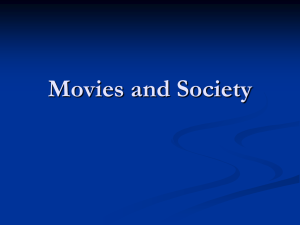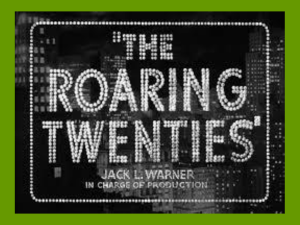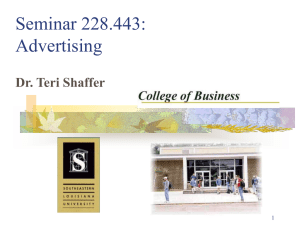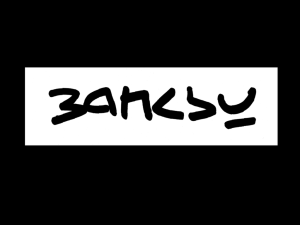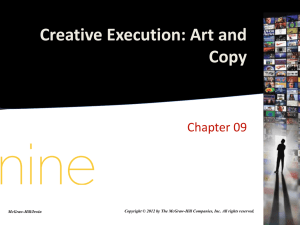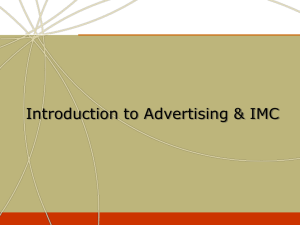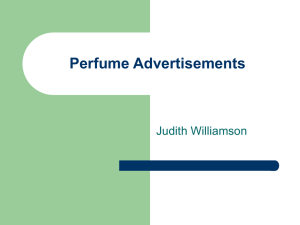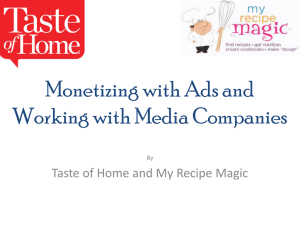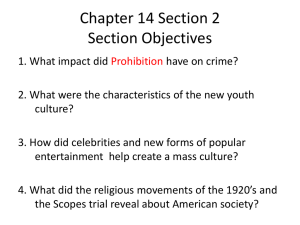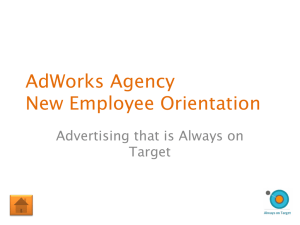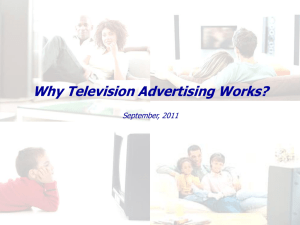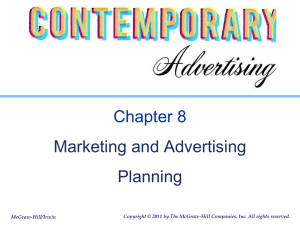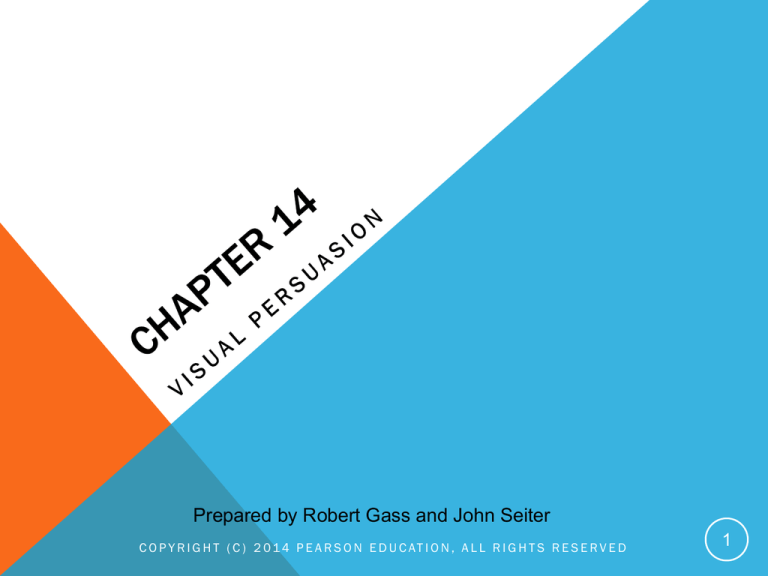
Prepared by Robert Gass and John Seiter
C O P Y R I G H T ( C ) 2 01 4 P E A R S O N E D U C AT I O N , A L L R I G H T S R E S E R V E D
1
IMAGE IS EVERYTHING
In Communication Studies, visual persuasion is often
overlooked, neglected
Persuasion’s traditional focus has been on oral and/or
textual messages
emphasis is on persuasion within the “world of words”
the role of images in general, and art in particular, has been
neglected
But images are highly persuasive
Picture superiority effect: pictures are more readily
recognized and remembered than words
C O P Y R I G H T ( C ) 2 01 4 P E A R S O N E D U C AT I O N , A L L R I G H T S R E S E R V E D
2
HOW IMAGES PERSUADE
Iconicity
An image stands for the thing it
represents
Uncle Sam is an icon for America
Indexicality
Images can document events.
Marines raising the flag on Iwo Jima
Syntactic Indeterminacy
Images lack syntax and logical
operators.
Advertisers associate brands with
idealized lifestyles
This painting by John Trumbull supposedly
“documents” the signing of the Declaration of
Independence. However, no such ceremony
actually took place.
Image courtesy of www.teachersparadise.com
C O P Y R I G H T ( C ) 2 01 4 P E A R S O N E D U C AT I O N , A L L R I G H T S R E S E R V E D
3
ART AS PERSUASION
Art serves more than an aesthetic The cover of the New Yorker
magazine depicted Barack and
or decorative function
Artists persuade in and through
their art
Michelle Obama as fist-bumping,
flag-burning, Muslim extremists
Danish cartoon caricatures of the
prophet Muhammad provoked
violent protests
Graffiti artist, Banksy, has
stenciled anti-established images
in public places
Art provides social critiques
Art can spark controversy
Art increases awareness
C O P Y R I G H T ( C ) 2 01 4 P E A R S O N E D U C AT I O N , A L L R I G H T S R E S E R V E D
4
CONTROVERSIAL ART
Banksy, a “guerilla artist”
stencils controversial images in
public places
“Napalm” depicts corporate
icons alongside a napalm victim
The image draws on Nick Ute’s
Pulitzer prize winning photo
The image critiques exploitation
by multinational corporations
Image courtesy of Banksy
http://www.banksy.co.uk/indoors/
napalm.html
C O P Y R I G H T ( C ) 2 01 4 P E A R S O N E D U C AT I O N , A L L R I G H T S R E S E R V E D
5
PRO-GOVERNMENT & ANTI-GOVERNMENT ART
The USSR used art to promote
the ends of the state
Chinese poster art deified
Chairman Mao
During the “New Deal” era, the
U.S. government sponsored
pubic arts projects
European artists aimed their art
against the government
Picassos’ Guernica” Eugene
Delacroix’s “Liberty Leading the
People” (1830)
Diego Rivera’s murals
C O P Y R I G H T ( C ) 2 01 4 P E A R S O N E D U C AT I O N , A L L R I G H T S R E S E R V E D
6
PRO-GOVERNMENT ART
This painting depicts the “New Deal” bringing electricity to rural America.
At the time nine out of ten farms had no electricity (David Stone,
Electrification, 1940)
C O P Y R I G H T ( C ) 2 01 4 P E A R S O N E D U C AT I O N , A L L R I G H T S R E S E R V E D
7
ANTI-GOVERNMENT ART
Picasso’s Guernica (1937) depicted the indiscriminant
bombing of a Basque town during the Spanish civil war. The
work symbolizes the horror of war and was directed at
Franco’s Nationalist forces
C O P Y R I G H T ( C ) 2 01 4 P E A R S O N E D U C AT I O N , A L L R I G H T S R E S E R V E D
8
HOW ART PERSUADES
Art shines a spotlight on society
Awareness through interpretation
Suzanne Lacy, “Three Weeks in May”
Awareness through participation
Wafa Bilal’s “Shoot an Iraqi” project
The Names Project
C O P Y R I G H T ( C ) 2 01 4 P E A R S O N E D U C AT I O N , A L L R I G H T S R E S E R V E D
9
CINEMATIC PERSUASION
Movies are a form of persuasion
They are carefully crafted works
They reach large audiences
Potential for mass influence
Movies are told in a narrative form
People gravitate toward stories
Stories possess an aura of believability
C O P Y R I G H T ( C ) 2 01 4 P E A R S O N E D U C AT I O N , A L L R I G H T S R E S E R V E D
10
CINEMATIC INFLUENCE
People may not expect to be persuaded during a movie
Viewers engage in a “willing suspension of disbelief.”
Films may persuade intentionally.
Michael Moore’s films
Inconvenient Truth
Brokeback Mountain
Films may persuade unintentionally
Juno
Superbad
C O P Y R I G H T ( C ) 2 01 4 P E A R S O N E D U C AT I O N , A L L R I G H T S R E S E R V E D
11
EXPORTING CULTURAL VALUES
American movies export cultural
values around the world
Western movies promote
positive values
democracy
Western movies promote
negative values
materialism
promiscuity
violence
equality
freedom
justice
C O P Y R I G H T ( C ) 2 01 4 P E A R S O N E D U C AT I O N , A L L R I G H T S R E S E R V E D
12
PROMOTING POPULAR CULTURE
Fashion
Leg warmers
Platform shoes
Stirrup pants
Hairstyles
Jennifer Aniston
Farah Fawcett
Dance
Disco
Breakdancing
Hip-Hop
Lifestyles
Counter-culture
Goth culture
Hip Hop Culture
Slang and expressions
“Show me the money.”
“Talk to the hand.”
“You had me at hello.”
“Life is a box of chocolates.”
C O P Y R I G H T ( C ) 2 01 4 P E A R S O N E D U C AT I O N , A L L R I G H T S R E S E R V E D
13
CINEMATIC SOCIAL PROOF
Movie characters model risky behaviors
Smoking
Smoking rates in cinema are disproportionately higher
than for the public at large (Omidvari, et al., 2005)
Alcohol abuse
Movies frequently depict underage drinking and driving
Unsafe sex
98% of movies with sex scenes make no mention of safe
sex (Gunasekera & Chapman, 2005)
Violence
Gratuitous violence is commonplace on the Big Screen
C O P Y R I G H T ( C ) 2 01 4 P E A R S O N E D U C AT I O N , A L L R I G H T S R E S E R V E D
14
CINEMATIC SOCIAL PROOF
Positive social modeling
Finding Nemo normalized disabilities
Guess Who’s Coming to Dinner tackled the subject of
racial integration.
Milk chronicled the gay rights movement.
Tomb Raider, the Terminator films, Resident Evil, and
other films portray smart, tough, empowered female
protagonists.
C O P Y R I G H T ( C ) 2 01 4 P E A R S O N E D U C AT I O N , A L L R I G H T S R E S E R V E D
15
CULTIVATION THEORY
heavy exposure to movies cultivates attitudes more
consistent with the media version of reality than with
reality itself
“Heavy” viewers have a more distorted view of the world
than “Light” viewers
Heavy viewers develop a view of a “mean, scary world”
Movies and TV provide biased, stereotyped depictions of
reality, which can distort the beliefs of heavy viewers
C O P Y R I G H T ( C ) 2 01 4 P E A R S O N E D U C AT I O N , A L L R I G H T S R E S E R V E D
16
PROMOTING VIEWER IDENTIFICATION
Stories in film overlap with viewers’ experience
Viewers may identify closely with a character
Rocky, Rudy, Slumdog Millionaire championed the
underdog.
Napoleon Dynamite, Pretty in Pink, Superbad
championed social outcasts.
C O P Y R I G H T ( C ) 2 01 4 P E A R S O N E D U C AT I O N , A L L R I G H T S R E S E R V E D
17
PERPETUATING STEREOTYPES
Movies equate beautiful/handsome
with good, ugly with bad
African/Black
Often depicted as drug dealers,
pimps, felons
Asians
Often depicted as undersexed,
romantically awkward, good at
martial arts
Hispanics
Often depicted as gang members,
Middle-Easterners
Often depicted as terrorists,
taxi drivers,
Females
Often depicted as thin,
beautiful, airheaded
Few leading roles for older
actresses
Few leading roles for heavy
actresses.
maids
C O P Y R I G H T ( C ) 2 01 4 P E A R S O N E D U C AT I O N , A L L R I G H T S R E S E R V E D
18
POSITIVE STEREOTYPES TOO
Many recent films have embraced diversity, promoted
intercultural awareness, and fostered interracial tolerance
Kite Runner
Joy Luck Club
Slumdog Millionaire
Gran Torino
My Big Fat Greek Wedding
C O P Y R I G H T ( C ) 2 01 4 P E A R S O N E D U C AT I O N , A L L R I G H T S R E S E R V E D
19
IMAGES IN ADVERTISING
Images are the bread and butter of advertising campaigns
Consumers viewed 4.6 billion ads in 2012*
In 2013, $518 billion will be spent on advertising
worldwide**
Almost $300 billion per year is spent on advertising in the
U.S.A.
The average person is exposed to 300-3,000 ads per day
The average person sees 1,700 banner ads per month***
C O P Y R I G H T ( C ) 2 01 4 P E A R S O N E D U C AT I O N , A L L R I G H T S R E S E R V E D
20
ANTI-ADS
Anti-ads parody traditional advertising
Smoking prevention ads satirize the glamorization of
cigarettes
GoDaddy’s ads simultaneously mock and emulate sex
appeals
Anti-ads appeal to skeptical consumers who distrust
advertising
Anti-ads appear to respect the viewer’s intelligence
C O P Y R I G H T ( C ) 2 01 4 P E A R S O N E D U C AT I O N , A L L R I G H T S R E S E R V E D
21
PRODUCT PLACEMENT
Product placement
Apple has placed its products in more than 1,500
TV shows.
James Bond movies always feature a cool car.
Windex was the cure for everything in My Big Fat
Greek Wedding.
Brandchannel.com lists product placements in
movies.
C O P Y R I G H T ( C ) 2 01 4 P E A R S O N E D U C AT I O N , A L L R I G H T S R E S E R V E D
22
IMAGE ORIENTED ADVERTISING
Luxury brands
Mercedes, Ralph Lauren, Prada
Aspirational brands
Rolls Royce, Tesla, Vera Wang
Genuine, authentic brands
Artisanal cheeses, organic
foods, handmade goods
Common associations in
advertising
Social status and elitism
Sex and romance
Cause-related
Power, speed, strength
Youth culture
Cool, hip, trendy
Safety security
Sense of place, belonging
C O P Y R I G H T ( C ) 2 01 4 P E A R S O N E D U C AT I O N , A L L R I G H T S R E S E R V E D
23
SHOCK ADVERTISING
Media clutter: consumers
are bombarded with 3,000
messages per day
Shock ads seek to stand
out against the background
of media clutter
Shock ads attempt to
exploit a norm violation
The goal is to be disturbing,
offensive, crass, tasteless,
edgy
capture attention by
braking through media
clutter
increase awareness,
recognition
generate media buzz
through social controversy
promote memory,
retention of an issue
C O P Y R I G H T ( C ) 2 01 4 P E A R S O N E D U C AT I O N , A L L R I G H T S R E S E R V E D
24
SHOCK ADVERTISING
Example: GoDaddy.com’s 2013 Superbowl
commercial, “Sexy meets smart”
Shock ads increase attention and retention
(Dahl,
Frankenberger, & Manchanda (2003)
Shock ads walk a thin line between not being
shocking enough and being offensive
C O P Y R I G H T ( C ) 2 01 4 P E A R S O N E D U C AT I O N , A L L R I G H T S R E S E R V E D
25
PHOTOGRAPHIC PERSUASION
The myth of
photographic
objectivity
Photographs are not
objective
representations of
reality.
Photography is a
subjective medium.
Photographers manipulate
the subject matter
framing
perspective
lighting
composition
film (color, black & white)
camera angle
focus
contrast
which images to print
cropping
shutter speed
C O P Y R I G H T ( C ) 2 0 1 4 P E A R S O N E D U C AT I O N , A L L R I G H T S
RESERVED
26
THE CAMERA ALWAYS LIES
Famous faked photos
The Cottingly Fairies
Loch Ness monster
John Kerry sharing the podium
with Jane Fonda
Brian Walski’s doctored Iraq photo
Adnan Hajj’s photo of thick black
some over Beirut, Lebanon
Tourist atop Twin Towers as plane
approaches
In the digital age images can
be manipulated more easily
Heads can be cropped and
replaced.
Lighting angles can be
altered.
New software is becoming
available for identifying digital
fakery
Newsweek alteration of O.J.
Simpson’s skin tone
C O P Y R I G H T ( C ) 2 01 4 P E A R S O N E D U C AT I O N , A L L R I G H T S R E S E R V E D
27




